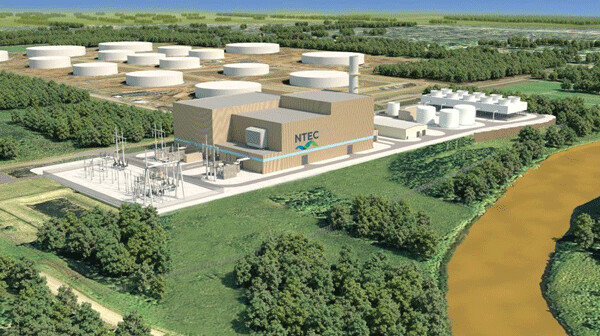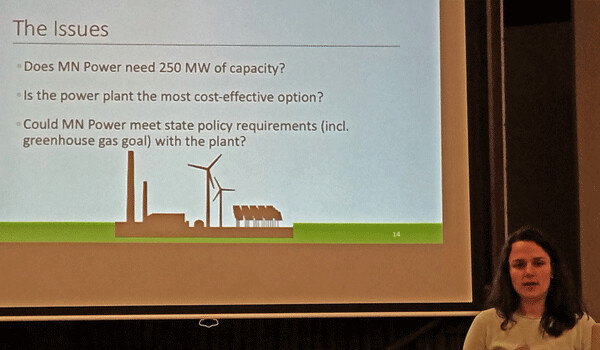News & Articles
Browse all content by date.

Minnesota Power plans to build a natural gas-fueled power plant in Superior. But citizen groups are questioning whether it’s a good idea, either for customers or the environment.
If all goes as planned, the $700 million power plant, to be called the Nemadji Trail Energy Center, will begin operation in 2025. It will be jointly owned with Dairyland Power Cooperative, with the two companies equally dividing the cost.
The plant is part of Minnesota Power’s “EnergyForward” plan by which renewable sources -- wind, solar, biomass and Canadian hydro -- will provide 44 percent of the energy supply by 2025. Coal will provide about 33 percent and natural gas around 23 percent. The project is estimated to create 260 construction jobs and employ 22-25 full-time workers.
The plant is expected to stabilize the energy supply for times when renewable energy capability is lower. “Natural gas is flexible, abundant, and you can call upon it when the sun’s not shining,” said Amy Rutledge, communications manager for ALLETE/Minnesota Power.
Rutledge acknowledged the cost of building the plant will be passed onto customers, but could not say whether it would result in higher rates. “It’s hard to predict where rates will be in seven years,” she said. “But through the regulatory process, Minnesota Power will have to demonstrate that this is the best cost resource to meet the needs of our customers. We believe it is and by partnering with another utility this allows MP access to economies of scale and efficiencies that wouldn’t be available if we were to build a smaller unit on our own.”

“There’s no evidence that Minnesota Power needs this capacity,” said Annie Levenson-Falk, executive director of the nonprofit Citizens Utility Board (CUB). “If they did need the power, there are cheaper ways to get it.”
She was speaking at a Feb. 20 presentation at Coppertop Church, sponsored by groups challenging the need for the plant. CUB conducted a poll of Minnesota Power customers last November and found that 77 percent did not support the new plant. Also 92 percent supported a full analysis of all energy options.
“Minnesota Power is part of a regional grid. Often their statements are couched in terms of this plant is that it’s renewable-enabling, that you would need this plant to be able to provide power when the sun doesn’t shine or when the wind doesn’t blow,” said Bret Pence of Minnesota Interfaith Power & Light. “Quite frankly, you don’t.”
“We’re part of a regional grid and all the time Minnesota Power’s an anchor utility in a fine dance between how much demand and how much supply is on the grid,” Pence said. “And they have their own portfolio of assets, which is what this is about, who pays for those assets. But the fact is that there’s a larger grid and you can buy wholesale market energy. In fact, right now in our regional energy district, there’s so much wind that sometimes the prices are negative, they want to pay people to take energy off the grids.”
Buddy Robinson, of the Minnesota Citizens Federation Northeast, said profits are the real reason Minnesota Power is pushing for a natural gas plant. “There’s a tiny, tiny algebra equation, the question of how much profit the utility makes. You take two things, you take the dollar value of their generating plant and power lines and other stuff, the buildings, equipment, etc., you multiply that by a percentage of profit that utility company is granted, called return on equity, and those two things multiplied together tell you what the total dollar amount of profit that they’re going to get … The natural gas plant costs more than wind and solar resources, then you automatically can stand to make more profit by going with a gas plant. You could endanger getting as much profit as you want if you go with the lower cost resources.”
The Sierra Club North Star Chapter has also weighed in against the plant, saying it will use natural gas extracted by the controversial process of hydraulic fracturing (fracking).
“Natural gas production from hydraulically fractured wells now makes up about two-thirds of total U.S. marketed gas production,” according to the U.S. Energy Information Administration.
Rutledge says it’s still unknown where the natural gas for the new plant will come from, but Superior is the hub of many natural gas lines.
Advocates also point out that Minnesota Power’s goal of 44 percent renewable energy by 2025 is not that impressive, considering Xcel Energy, of the Twin Cities, is looking to reach 60 percent renewable by 2030. But it’s not fair to compare the two companies, said Rutledge, since Xcel Energy is more residential-based and Minnesota Power has a greater percentage of industrial customers. Also, Xcel relies partly on nuclear power.
The Public Utilities Commission will hold a public hearing 4-6 p.m. on Wednesday, Feb. 28 at the Inn on Lake Superior, 325 S. Lake St. S. in Duluth.
Comments can also be made online at mn.gov/puc, opening sometime in mid-February. (Scroll to bottom, by Speak Up!, click on “open for comment,” click on "open discussions" and find docket 17-568.) Comments (marked Minnesota Power Gas Plant Case 17-568) may also be emailed to consumer.puc@state.mn.us or mailed to Minnesota Public Utilities Commission, 121 7th Place East, Suite 350, St. Paul, MN 55101. Deadline for comments is March 23.
| Tweet |


